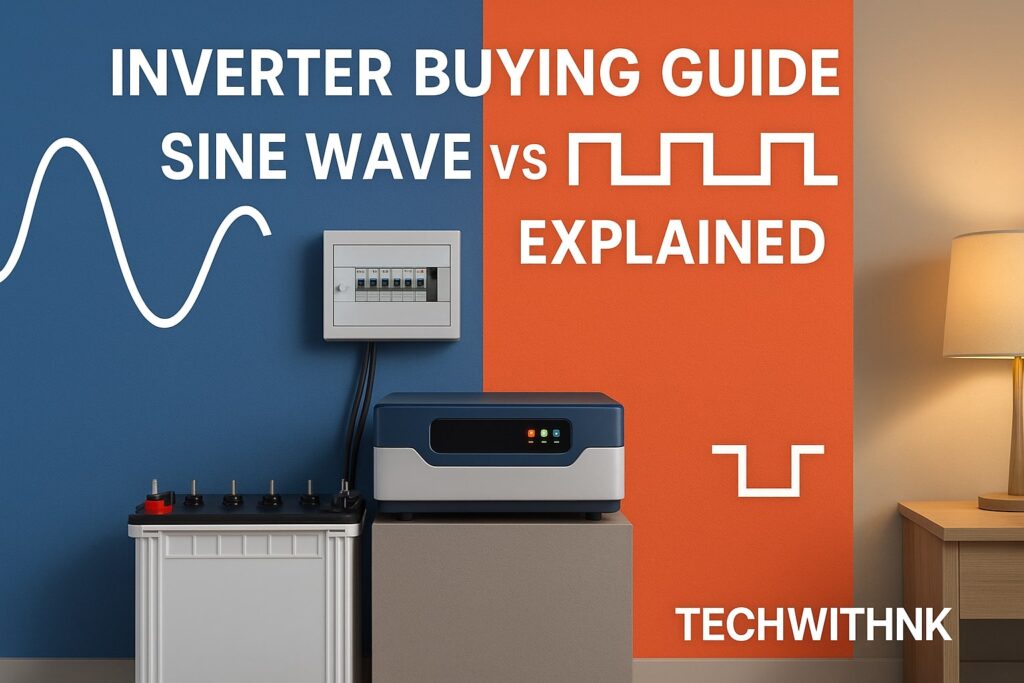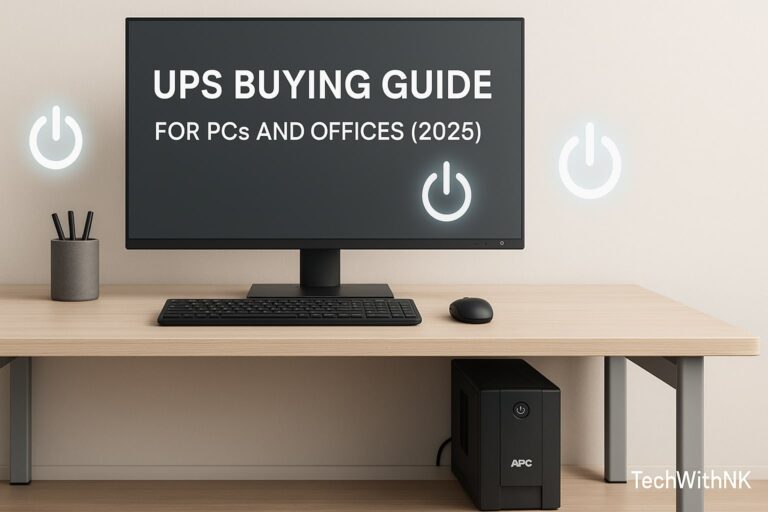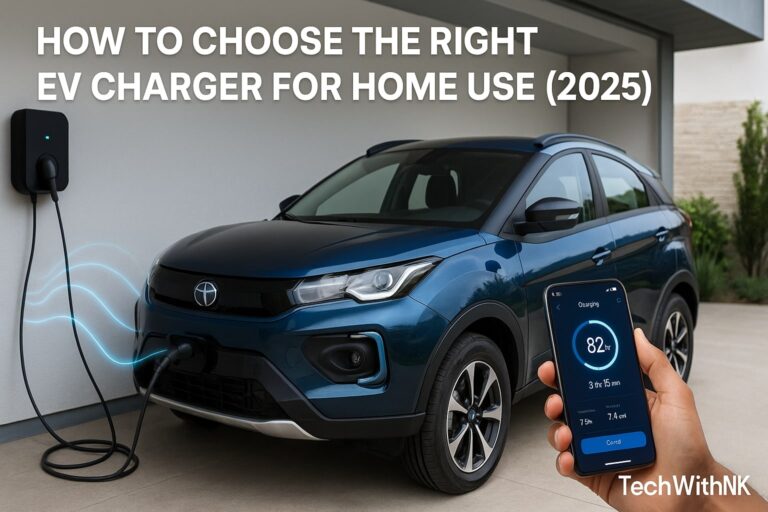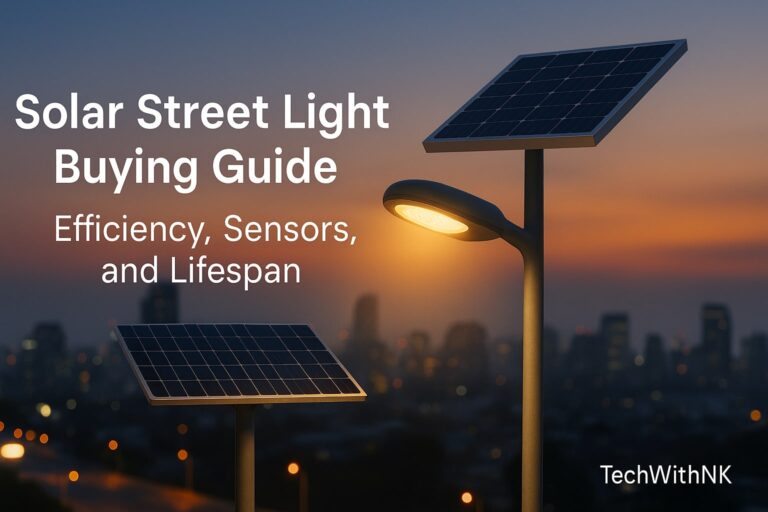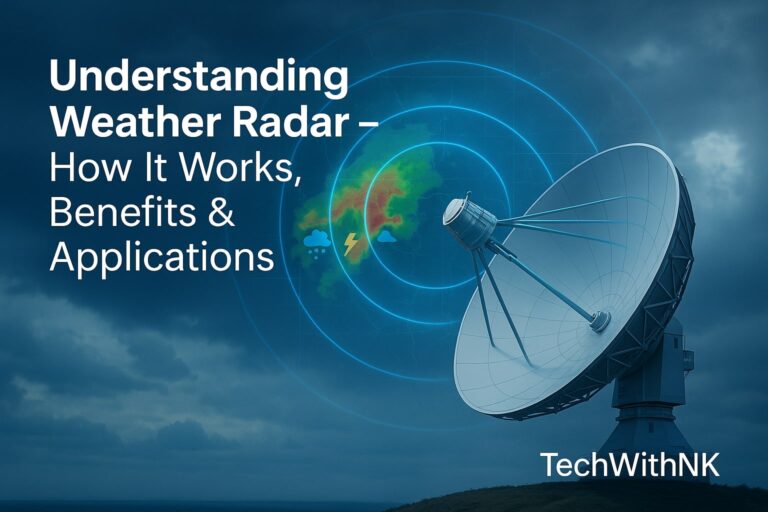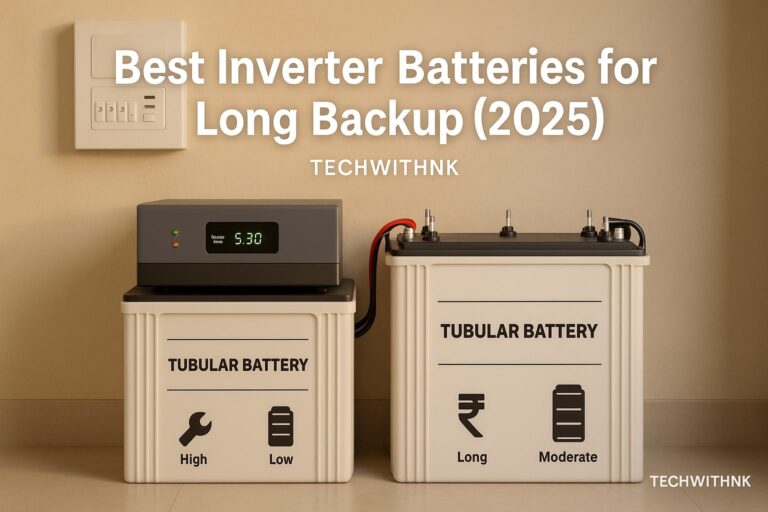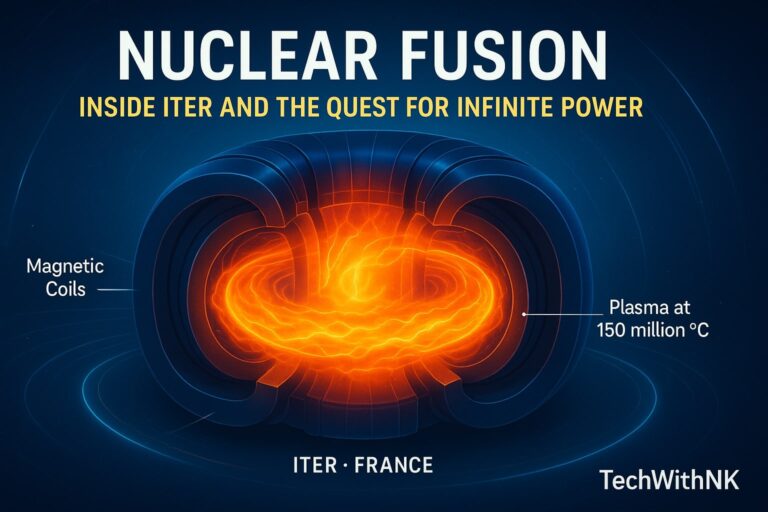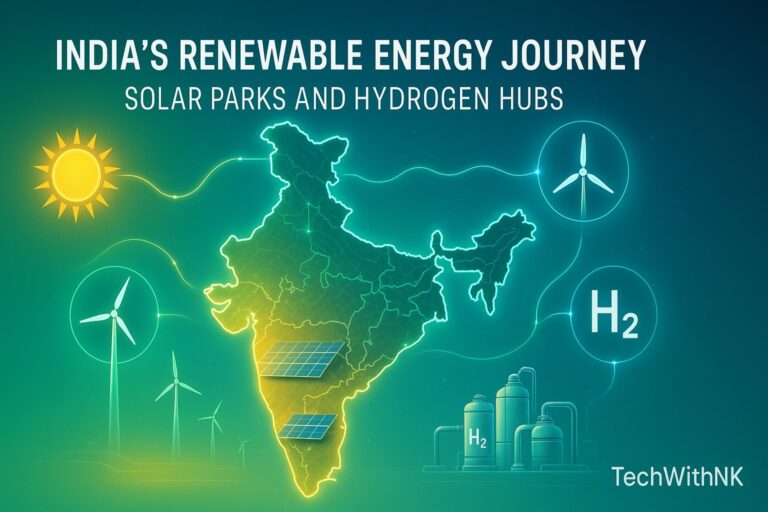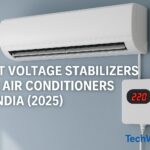🏠 Introduction
Electricity power cuts are still common in many parts of India. Whether it’s summer heat or monsoon storms, uninterrupted power is essential for lights, fans, and even sensitive electronics. That’s where an inverter becomes the heart of your home backup system.
But when you go shopping, you’ll see terms like “Sine Wave,” “Square Wave,” and “Modified Sine Wave” written on every box. What do these really mean? How do they affect the performance of your appliances? And most importantly—which one should you buy?
This inverter buying guide by TechWithNK will explain everything you need to know before choosing the right inverter for your home.
⚙️ What is an Inverter?
An inverter is an electronic device that converts DC (Direct Current) from a battery into AC (Alternating Current)—the form of electricity used by most household appliances.
When power cuts occur, the inverter draws power from its battery and supplies AC current to your home’s wiring, ensuring your fans, lights, and TVs keep running seamlessly.
🔋 Basic Working Principle of an Inverter
🧠 Step-by-Step Process:
Battery Storage: Stores DC energy from mains supply or solar panel.
DC to AC Conversion: Inverter circuit switches DC rapidly using electronic components (MOSFETs/IGBTs).
Waveform Generation: Depending on design, output can be sine, modified sine, or square wave.
Output to Home: Supplies AC voltage (230V, 50Hz) to your household circuits.
⚡ Real-life Analogy:
Think of an inverter as a translator—converting the “language” of electricity that your battery speaks (DC) into the “language” your appliances understand (AC).
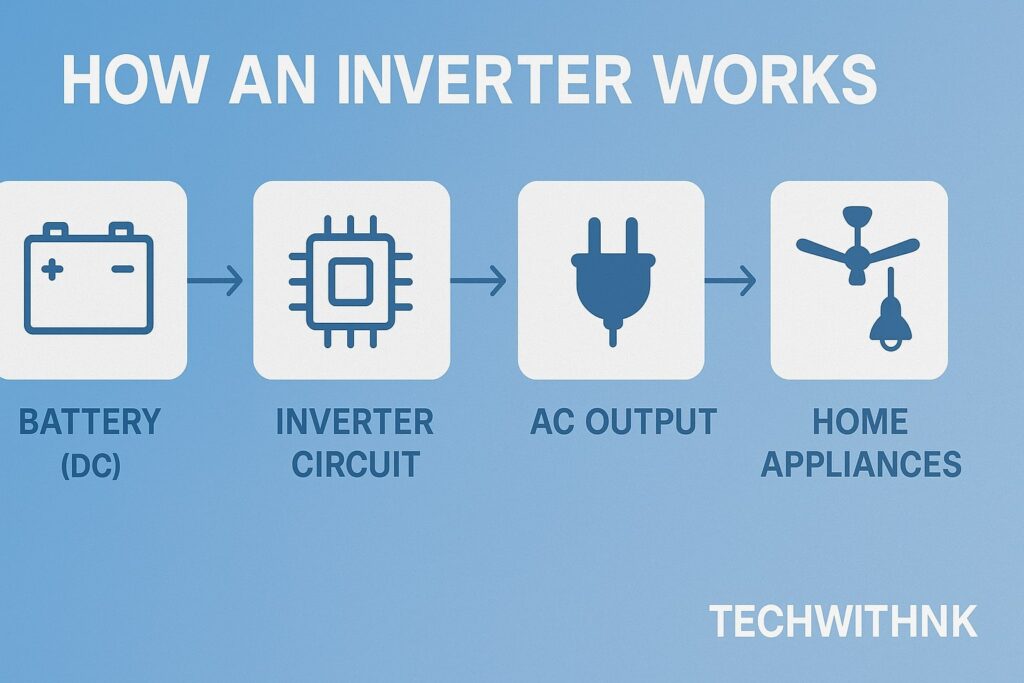
🌀 Types of Inverters by Waveform Output
| Type | Waveform | Appliance Compatibility | Cost | Efficiency | Ideal For |
|---|---|---|---|---|---|
| Square Wave | Sharp on/off waveform | Basic appliances (fans, bulbs) | Low | Medium | Budget homes, rural areas |
| Modified Sine Wave | Stepped approximation of sine | Mix of appliances (TV, small motors) | Medium | Good | Small offices, mid-range homes |
| Pure Sine Wave | Smooth AC waveform like grid power | All sensitive devices (fridge, AC, computer) | High | Excellent | Urban homes, offices, industri |
🎯 Sine Wave vs Square Wave – Key Difference Explained
⚡ 1. Waveform Shape
Sine Wave: Smooth and continuous waveform, similar to electricity from the grid.
Square Wave: Abrupt on/off pulses, like switching power on and off instantly.
⚡ 2. Power Quality
Sine Wave: Produces clean power with minimal harmonic distortion.
Square Wave: Creates more electrical noise and distortion.
⚡ 3. Appliance Compatibility
Sine Wave: Perfect for all appliances, especially motors, refrigerators, computers, and TVs.
Square Wave: Suitable only for resistive loads (bulbs, fans).
⚡ 4. Performance & Efficiency
Sine Wave: Runs appliances smoother and cooler.
Square Wave: Causes humming, heat, and reduced efficiency in inductive devices.
⚡ 5. Cost
Sine Wave: More expensive due to complex circuitry.
Square Wave: Budget-friendly, simple design.
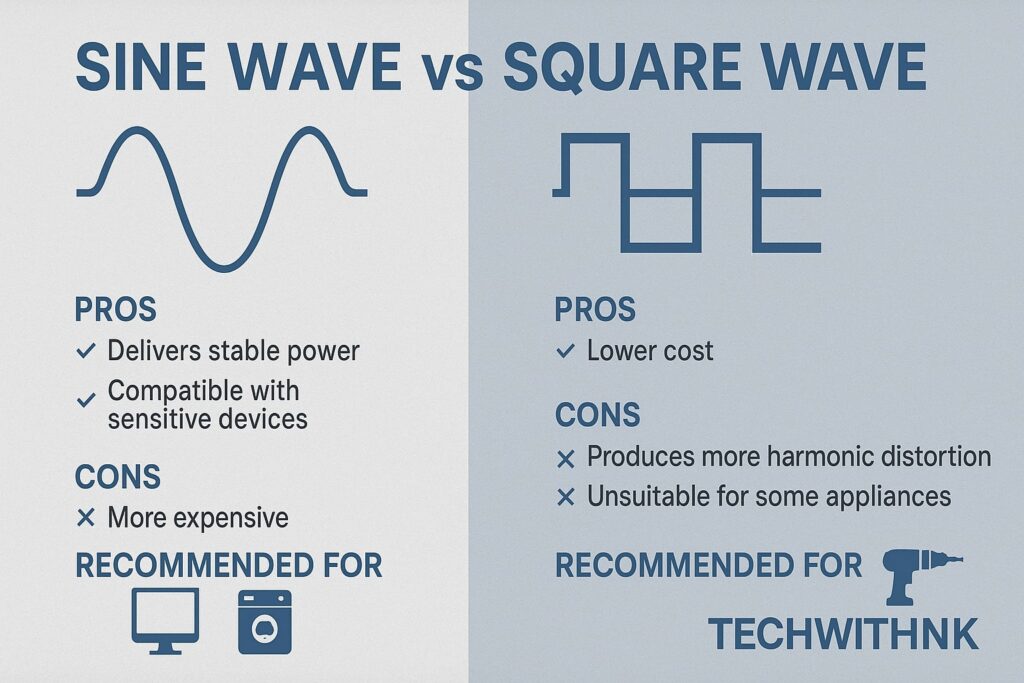
🧠 Why Sine Wave Inverters Are Better for Modern Homes
Most modern appliances—like LED TVs, refrigerators, washing machines, routers, and laptops—use microprocessors and SMPS-based circuits that require pure sine wave input.
✅ Advantages of Sine Wave Inverters:
Clean power identical to mains supply.
Safe for sensitive electronics.
Silent operation—no humming noise.
Longer lifespan of both inverter and appliances.
Better efficiency and battery utilization.
If you want peace of mind and long-term performance, a sine wave inverter is the best choice despite the higher cost.
🧾 Modified Sine Wave – The Middle Ground
A modified sine wave inverter produces a stepped waveform that’s closer to sine but still not perfect.
✔️ Pros:
Cheaper than pure sine wave.
Can handle basic electronics and small motors.
Better than square wave for mixed loads.
❌ Cons:
Can still cause flickering in CFLs or heating in motors.
Not recommended for heavy or sensitive appliances.
⚡ Power Rating and Capacity
Choosing the right inverter capacity depends on how many appliances you want to run during a power cut.
⚙️ Step 1: Calculate Total Load
Add up the wattage of all devices you want to run:
| Appliance | Power (W) | Quantity | Total |
|---|---|---|---|
| Fan | 80W | 3 | 240W |
| Tube Light | 40W | 3 | 120W |
| LED TV | 100W | 1 | 100W |
| Laptop | 60W | 1 | 60W |
| Total Load | 520W |
⚙️ Step 2: Convert Watts to VA
Inverters are rated in VA (Volt-Ampere), not Watts.
To convert:
VA = Watts ÷ Power Factor (usually 0.8)
Example: 520 ÷ 0.8 = 650 VA
So, you should choose an inverter rated around 700 VA or higher.
🔋 Battery Selection – The Real Powerhouse
The battery is the backbone of your inverter system.
| Battery Type | Lifespan | Maintenance | Cost | Ideal Use |
|---|---|---|---|---|
| Flat Plate | 3–4 years | Regular water top-up | Low | Short power cuts |
| Tubular Battery | 5–7 years | Low maintenance | Medium | Long power cuts |
| Lithium-ion | 7–10 years | Maintenance-free | High | Modern homes, solar inverters |
Always ensure the Ah rating (Ampere-hour) matches your backup requirement.
Formula:
Backup (hours) = Battery Capacity (Ah) × Battery Voltage (V) / Load (W)
, pulvinar dapibus leo.
🛒 Inverter Buying Checklist
✅ Choose waveform type (Pure Sine Wave preferred)
✅ Check inverter capacity (VA rating)
✅ Select suitable battery type (Tubular recommended)
✅ Verify brand reputation and warranty
✅ Look for smart features (LCD display, fast charging, solar compatibility)
✅ Consider service network and spare availability
🏆 Top Inverter Brands in India (2025)
Microtek
V-Guard
Exide
Livguard
Amaron
Genus
Each brand offers sine wave models with digital display, smart charging, and longer battery life.
🧮 Example – Recommended Setup for Indian Homes
Requirement: 3 fans, 3 lights, 1 TV, 1 router
Load: 520W → 700 VA inverter
Battery: 150Ah tubular (Exide or Luminous)
Type: Pure sine wave inverter
Backup: Around 3–4 hours
⚡ Sine Wave vs Square Wave – Quick Comparison Table
| Feature | Sine Wave | Square Wave |
|---|---|---|
| Power Quality | Excellent | Poor |
| Appliance Safety | Safe for all | Only basic |
| Noise | Silent | Humming sound |
| Efficiency | High | Medium |
| Cost | Expensive | Cheap |
| Recommended For | All appliances | Fans, lights only |
🌞 Bonus: Solar-Compatible Inverters
With the rise of renewable energy, many homeowners are now switching to solar hybrid inverters that can charge batteries using both solar panels and grid power.
Look for features like:
MPPT/PWM solar charge controller
Dual input (grid + solar)
Smart LCD display
Battery protection modes
These are the future of clean and reliable home power solutions in India.
💡 Conclusion
Choosing the right inverter isn’t just about price—it’s about protecting your appliances, ensuring safety, and enjoying uninterrupted comfort during power cuts.
For most modern homes, a Pure Sine Wave inverter with a tubular battery offers the best balance of performance, durability, and safety.
Spend a little more today, and save your appliances tomorrow.
What is the difference between sine wave and square wave inverters?
Sine wave inverters produce power similar to the grid, safe for all devices. Square wave inverters are cheaper but not suitable for sensitive electronics.
Can I use a square wave inverter for a refrigerator or washing machine?
No. These appliances need smooth power; always use a sine wave inverter.
What capacity inverter is ideal for a 2BHK home?
Usually, a 700–900 VA inverter with a 150Ah tubular battery is sufficient.
